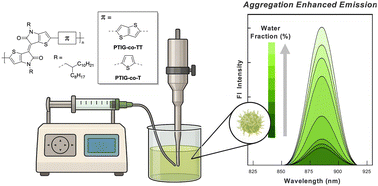Near-infrared (NIR) emitting materials underpin emerging medical diagnostics and therapeutic bionanotechnologies. Conjugated polymer nanoparticles offer unique advantages due to their remarkable absorption cross-sections, photostability, synthetic tunability, and biocompatibility. Despite the vast library of NIR-absorbing conjugated polymers, relatively few narrow bandgap structures have been explored for NIR imaging. Herein, we investigate thienoisoindigo copolymers (PTIG-co-TT and PTIG-co-T), well-established semiconductors for organic bioelectronics and photovoltaics, as NIR emitters. Both polymers demonstrated weak emission in solution, which upon processing into the nanoparticle form factor displayed a remarkable, previously unexplored aggregation-enhanced emission (AEE) by multiple orders of magnitude. Careful matching of molecular weight and nanoparticle size between the two systems revealed the role of backbone flexibility on nanoparticle brightness; the AEE was more pronounced in the more planar PTIG-co-TT. Both formulations featured extraordinary brightness and photostability, outperforming clinical standard indocyanine green while displaying peak emission at ∼880 nm, making them strong alternatives that can be directly applied with current hardware for NIR cancer diagnostics and image-guided surgery. The unexpected NIR optical performance of otherwise well-established organic semiconductors suggests there may be untapped potential for this class of materials as imaging agents.
